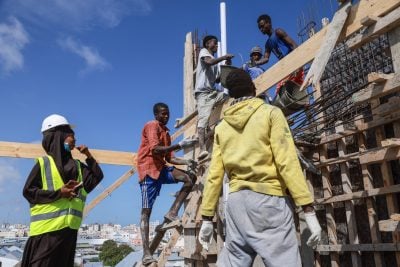Lagos has a well-deserved reputation for traffic chaos. The constant honking of car horns is the anthem of the megacity; a significant proportion of the more than 20m residents of Africa’s largest metropolis are used to spending hours every day entombed in gridlock as they grind along highways whose builders could never have imagined the volume of traffic they would one day handle.
It came as a moment for relief, therefore, when the city’s new Blue Line light rail route finally opened last year. After a planning and construction process stretching back over two decades, the first train on the Chinese-built project pulled out of the new Lagos Marina station on the western shore of Lagos Island, near the city centre, on 4 September.
The Blue Line offers commuters a smooth and modern journey. The new trains are air-conditioned. WiFi is available. Television screens show music and football videos. Guards from the Lagos Neighbourhood Safety Corps provide security.
The train runs along a raised track that hugs the shoreline of Lagos Island, then descends to run along the central reservation of the Lagos-Badagry Expressway after reaching the mainland. A journey between Marina and the current terminus at Mile 2 station takes around 25 minutes. The same journey in a car, if attempted at rush hour, could easily take more than twice as long.
While some criticisms can be made of the Blue Line – little attempt has been made at the stations to offer car parking or connections to other forms of public transport – the real problem for Lagos is that there is a limit to how much difference a single light rail project can make. The city desperately needs many more projects of this nature if it is to cope with its projected population increase in the years ahead.
Space and time
Unfortunately, building mass transit projects requires a commodity that is in short supply in Lagos: space. The city’s population explosion has been accompanied by a scramble to plant houses on any available land – and the millions of Lagosians now living in unplanned suburbs cannot easily be moved.
The reality that Lagos has grown in a largely ad hoc manner presents “a very big challenge”, says Lookman Oshodi, project director at Lagos-based consultancy Arctic Infrastructure. Managing any aspect of the transport system is more difficult in an unplanned city, he says, noting that the lack of planning has given rise to various “unsustainable transportation practices”.
Various plans have been drawn up over the course of the last few years at the federal, state and local government levels, covering multiple aspects of urban planning. A “masterplan” for urban transport in Lagos was in fact published in 2002 by none other than President Bola Tinubu, during his time as governor of the state. Turning plans into action is no easy task, however.
“One thing is to prepare the plan, another thing is the level of implementation,” says Oshodi. He points to a lack of cohesiveness in bringing the various plans together. “Implementation is still not where it should be. It’s just not there yet.”
The lack of effective planning is reflected in Lagos’ unwanted position in the Economist Intelligence Unit’s city liveability index. Out of 173 major cities globally, Lagos is ranked as the fourth-least liveable, beating only Damascus, Tripoli and Algiers.
“It is difficult to be optimistic,” says Tayo Awomosu, chairman of the Lagos State Chapter of the Nigerian Institute of Town Planners. He echoes Oshodi in arguing that the failure of the authorities to prevent unchecked residential development is at the heart of the city’s challenges. “The government doesn’t have the wherewithal to be everywhere at the same time. They’re overwhelmed.”
Awomosu adds that the government’s refusal to be more interventionist in the housing market is a key problem. No government-built social housing has been constructed since 1983, he says, meaning that the urban poor have little choice but to try to erect makeshift dwellings in the absence of affordable housing offered by the private sector.
“I think that government intervention in the housing market is very essential,” says Awomosu. Along with more social housing, he argues that substandard units need to be rebuilt, the mortgage market needs to be reformed, and authorities need to promote more high-rise developments so that space can be used more efficiently.
Hard and soft infrastructure
The opening of the first phase of the Blue Line is one of the first real signs that progress is being made towards realising the vision that Tinubu drew up more than 20 years ago, of a city criss-crossed by multiple rail lines.
The Blue Line will eventually be extended to serve another eight stations, on top of the five included in the first phase. Another route, to be known as the Red Line, is slated to open this year and will take commuters from Marina to the northern suburb of Agbado. The timetable for opening the Green, Purple, Yellow and Orange lines remains unclear.
Incremental improvements to bus and ferry transport are also being made. But with the city’s population continuing to rise beyond 20m, the challenges of urban planning will only continue to grow.
These challenges cannot be met simply by building more and more “hard” infrastructure. “We also should be looking at non-motorised transportation in Lagos,” says Yinka Jones, programme manager at the non-profit Lagos Urban Development Initiative (LUDI). Better urban design can encourage walking and cycling, he says, helping to relieve pressure on the roads.
Jones says that LUDI has put forward a proposal for a “linear park”, which would offer long-distance walking and cycle paths around the city’s remaining wetlands to help improve connectivity. So far, however, the response from the authorities has been non-committal, he laments.
The wetlands, indeed, serve as a key piece of natural “infrastructure” that could play a key role in mitigating the effects of climate change on Lagos. Most of the city sits precariously on land that is increasingly vulnerable both to riverine flooding and to rising sea levels. As a natural drainage mechanism, wetlands are vital to help combat flood risks; yet vast tracts have already given way to unchecked urban sprawl.
“To be resilient, we need to preserve the wetlands,” says Awomosu. “They are actually there to take water when the water level rises, but we keep developing them and encroaching on them.”
The collective benefits of preserving wetlands provide another example of how the city needs to find better ways to use its space. With a better approach to planning, it is possible that liveability can finally start to improve. After all, as Awomosu says, “the solutions are not rocket science.”
Want to continue reading? Subscribe today.
You've read all your free articles for this month! Subscribe now to enjoy full access to our content.
Digital Monthly
£8.00 / month
Receive full unlimited access to our articles, opinions, podcasts and more.
Digital Yearly
£70.00 / year
Our best value offer - save £26 and gain access to all of our digital content for an entire year!
 Sign in with Google
Sign in with Google 



